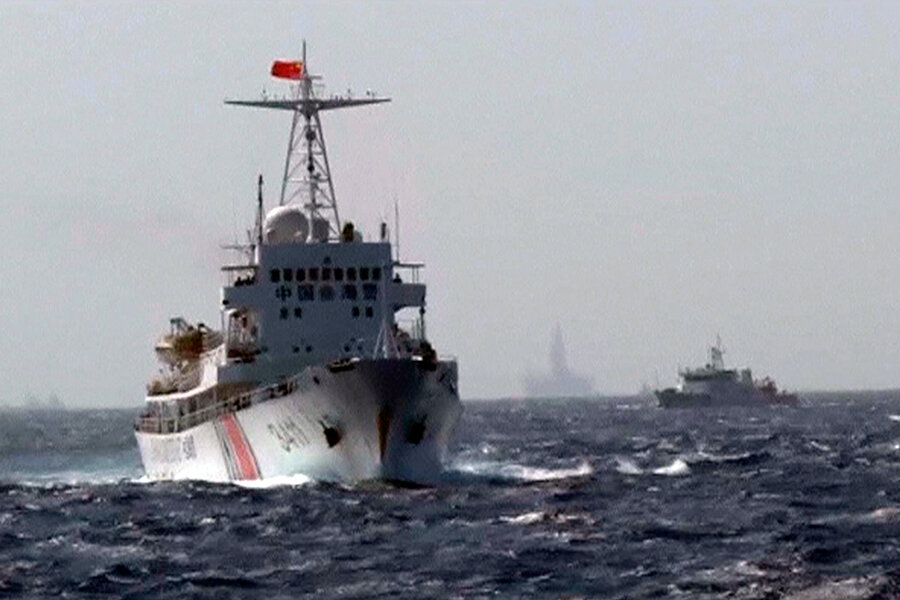Sea turtles, cannons, and arrests: What's going on in the South China Sea?
Loading...
| Taipei, Taiwan
Two incidents over disputed territory in the South China Sea this week threaten to disrupt the tense status quo between China and its southeast Asian neighbors.
In Vietnam, China's dispatch of a state-owned oil rig into waters close to Vietnam sparked a face-off between Chinese and Vietnamese ships and anti-China protests. In the Philippines, China is protesting the detention of a Chinese fishing boat filled with illegal sea turtles and the arrest of its crew.
While the region has been home to competing territorial claims for centuries, increasingly assertive action by both China and its neighbors has raised concerns that more serious conflict could erupt.
Here's what you need to know about the latest incidents:
1. What is the dispute between China and Vietnam, and how serious is it?
On May 3, China sent a 40-story high, football-field sized oil rig into territory claimed by both Vietnam and China, about 130 nautical miles off the coast of Vietnam. The deep-sea rig was reportedly accompanied by 80 Chinese ships.
Vietnam responded by sending its own vessels, which rammed Chinese ships at least 171 times, Chinese officials said. Vietnamese officials accused China of firing water cannons at Vietnamese ships.
Vietnam harbors decades of territorial and political grievances against China, easily fueling popular protests when bilateral spats arise. Anti-Chinese protesters in southern Vietnam last night set fire to several factories they believed were Chinese-owned.
There are signs of some diplomatic action: China and Vietnam had “14 communications” last week about the oil rig, the spokeswoman for the Chinese Foreign Ministry, said at a briefing on Monday.
2. What is the dispute between China and the Philippines, and how serious is it?
On May 6, the Philippines maritime police seized a Chinese fishing boat and its 11-person crew. China has demanded the return of the boat and the crew and said they were operating in China's "undisputed" territory.
Manila is instead putting nine of the crew members on trial for criminal offenses, after sending home two minors. The move is popular among Filipinos who feel bullied by China, but one that risks economic sanctions from Beijing.
The Philippines is known as one of the most aggressive challengers to China's territorial claims. It has opened international arbitration cases with the United Nations challenging Beijing's claims. Beijing has ignored the cases and has not sent lawyers to the UN.
3. Are these tensions in the South China Sea likely to escalate into fighting?
Observers forecast more scuffles such as the Vietnam-China incident, especially if Vietnam and the Philippines keep challenging China, which has a much larger military.
“In this highly charged environment there is always the possibility of an accident, which could result in an escalation of tensions,” says Murray Hiebert, senior fellow at the US think tank Center for Strategic and International Studies.
However, the parties aren’t testing one another with aggressive naval movements or air force flyovers. South China Sea territorial flare-ups usually alternate with periods of conciliation, when rivals hold talks.
4. Is China asserting its territorial claims more forcefully now than in the past?
Six governments claim all or part of the South China Sea, which is known for international shipping lanes, fishing grounds, and up to 7.5 billion barrels of undersea oil. China, Taiwan, the Philippines, and Vietnam say virtually the whole sea is their own, including hundreds of atolls and barely inhabited islets. Brunei and Malaysia claim parts of the South China Sea.
Disputes in the area emerged after World War II, heating up in the 1970s with occasional maritime scuffles. China clashed with Vietnam in 1974 and 1988 over competing ocean rights. China, Vietnam, and the Philippines most often appear on the front lines. The other claimants keep a low profile to maintain relations with China, though Taiwan periodically reminds its rivals of a military airstrip it operates on Taiping island in the Spratlys.
China has become more aggressive as its economic and political clout in the region has grown. It wants access to the ocean’s fisheries to feed its 1.3 billion people, and oil or natural gas to power its factories and cities. Beijing can now afford to take a tougher line against smaller Southeast Asian countries that increasingly depend on it for trade or investment.
China bases its oceanic claim on a U-shaped “nine-dash line" that extends south of Hong Kong. It says this is a traditional boundary that was referenced as far back as the Tang Dynasty about 1,500 years ago. Political analysts call China’s basis for sovereignty inconsistent with today’s international laws of the sea.
5. Is there a long-term solution?
The Association of Southeast Asian Nations voiced concern over the Vietnam-China upset at a meeting in Myanmar Saturday and vowed to work on an updated code of conduct for the sea. The 10-member bloc has pushed since 2002 for a code to head off accidents, but China has declined to sign one, preferring bilateral agreements. Southeast Asia is also relying more on the United States, which Beijing fears has jumped in to check China’s growth as a rival world superpower.
“[China] certainly increases the likelihood of other nations looking for more US involvement,” says David Dapice, chief economist with the Harvard Kennedy School’s Vietnam Program. Last month Washington agreed to station more troops in the Philippines. This month it slammed China’s placement of the oil rig in an exploration bloc that Vietnam had awarded to Exxon Mobil.
The six claimants will for the most part rely on an unspoken, self-enforced agreement to steer away from parts of the South China Sea most often used for fishing, oil exploration or military exercises. An updated code of conduct, augmenting the 1982 UN Convention of the Law of the Sea, would back up that deal in case competing vessels, oil rigs, or personnel come into contact at sea. Still, Southeast Asian nations have failed to get China on board.






